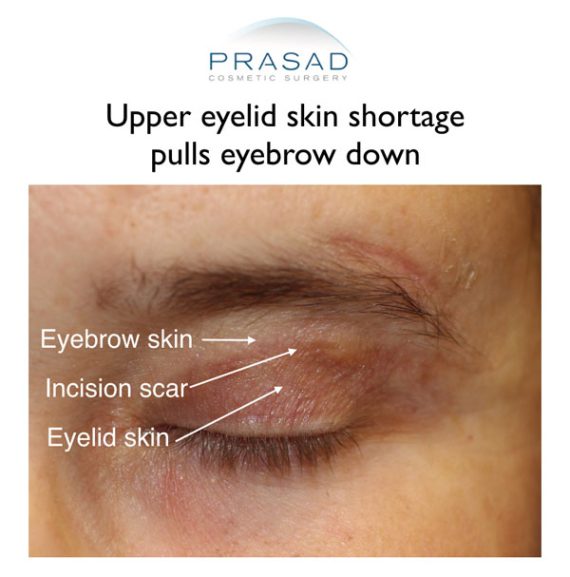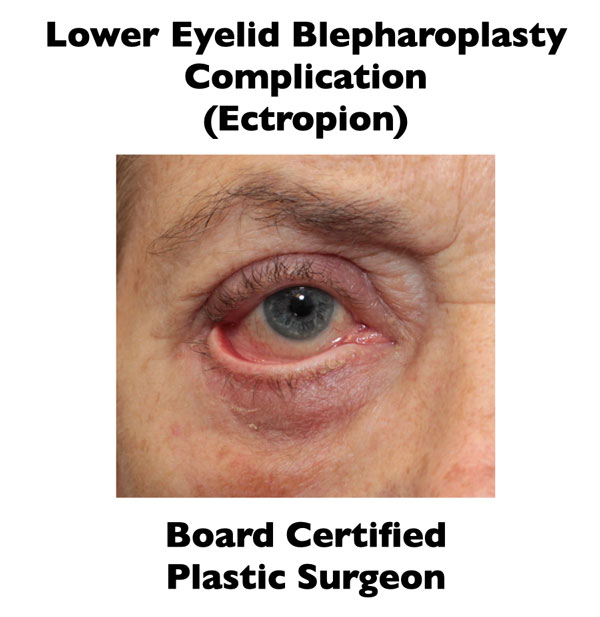Blepharoplasty Revision: Overcoming the Challenge of Eyelids that Won’t Close

Cosmetic eyelid surgery is a delicate and precise procedure, where the difference between an outstanding result, and a complication such as eyelids unable to close properly can be measured in millimeters.
Eyelid surgery typically ranks at about #3 in the top five cosmetic surgery procedures year after year. Due to the law of supply and demand, this means general plastic, general cosmetic, and even other types of surgeons offer cosmetic eyelid surgery. However, when it comes to revising complications after cosmetic eyelid surgery such as the eyes not properly closing, the specialist of choice is a Fellowship-trained oculoplastic surgeon.
I’ll explain how I approach complications from eyelid surgery for people who come to me from around the world.
As a cosmetic oculofacial plastic surgeon, I regularly perform primary cosmetic upper and lower eyelid surgery, as well as revision surgery to correct surgeries originally performed by other doctors, and reconstructive surgery of the eyelids.
Upper Blepharoplasty: Complications, Causes, and Revision
Skin shortage following upper eyelid surgery is a serious problem. To treat eyelid hooding, cosmetic upper eyelid surgery involves meticulously measuring and excising stretched or extra eyelid skin. Furthermore, fat can be scuplted to enhance the shape and appearance of the eyes.
When too much eyelid skin is removed during surgery, it might have a negative impact on eye health because the eyelids are unable to close properly. Another cause of eyelid skin shortages is the removal of eyelid skin without first treating eyelid ptosis.


Eyelid ptosis is a disorder in which the upper eyelid is lower than normal, causing one to look sleepy. This drooping of the eyelid is related to the function of the levator muscle which lifts the eyelid.
Eyelid ptosis surgery necessitates substantial knowledge and experience, which is not included in any plastic, or cosmetic surgery Board certification, but rather in Fellowship-training for oculoplastic surgery.
To become an oculoplastic surgeon, you must first complete an ophthalmology training program. I’ve noticed that general plastic surgeons frequently do not recognize ptosis, so they remove upper eyelid skin for cosmetic enhancement, even when there is very little skin to remove. In these cases, the eyelid skin is removed, but the eyelid remains droopy because the ptosis was not addressed. Eyelid skin removal in treating ptosis often causes a shortage of eyelid skin.
Lower Blepharoplasty: Complications, Causes, and Revision
When lower eyelid skin is removed after surgery, a skin shortage may occur. Doctors frequently remove skin from the lower eyelids because they believe it is superfluous and causes wrinkles. Lower blepharoplasty is a surgical procedure that is commonly used to treat under eye bags. The skin may appear to sag because bone loss is a major cause of face aging, particularly around the eyes and cheeks. Furthermore, aging, sun exposure, and other health conditions all have an impact on skin quality, resulting in wrinkles. Skin quality can be improved without removing the skin.
The lower eyelid position is dependent on a precise balance of skin, muscle, and tendons. This delicate balance is jeopardized when surgery such as a transcutaneous blepharoplasty involves making an incision beneath the eyelashes, and removing skin.


Lower eyelid skin shortages can lead to problems, including retraction, and ectropion. I commonly perform lower eyelid surgery by addressing the swollen under eye bags from the inside using a procedure known as transconjunctival blepharoplasty, which maintains this delicate balance. At the same time, I address wrinkles with various types of lasers, or radiofrequency technology, as well as regenerative medicine technologies like PRP or platelet-rich plasma. If a fold of skin overlaps, I will perform a restricted skin pinch excision blepharoplasty.
With a background in ophthalmology, I always emphasize to my patients the significance of good eyelid function for good eye health. For example, the simple motion of blinking is important because the eyelids act like windshield wipers, distributing your tears uniformly across the front surface of your eye.
For best vision, the cornea, or clear component of the eye, must be properly lubricated. People with an eyelid skin deficiency complain of irritation, such as foreign body sensation and dry eyes, because the eyelids are unable to properly lubricate the eye’s surface.
Patients with upper or lower eyelid skin shortage report difficulty sleeping because their eyes do not fully close, leaving a gap that causes discomfort, mucus production, and blurry vision.
No surgeon is immune from coping with problems or unexpected consequences. However, effective management of problems is crucial.


Much of eyelid surgery difficulties, such as skin shortage, retraction, or undiagnosed ptosis, can be addressed using the fundamental principle of restoring anatomy for function, and best appearance.
I find that many patients who come in for revision eyelid surgery have had multiple attempts by the original surgeon to address the patient’s condition with failed surgical techniques, which often make matters worse.
Blepharoplasty Revision Process
When evaluating a patient who has trouble closing their eyes, I first consider the urgent care of the eye to guarantee the preservation of vision and ocular function. I check for specific anatomical flaws, such as skin deficiency or interior tissue scarring.
I decide whether it is best to wait and allow for tissue relaxation to improve the patient’s eye closure without surgery. If there is a severe shortage of upper eyelid skin, a skin graft may be an option.
When the balance of anatomic components in the lower eyelids is disrupted, treatments such as skin grafting, lower eyelid support grafting, and repair of the lateral canthal tendon, which supports the eyelid, are often needed.
In cases where eyelid ptosis was not addressed during surgery, I approach the problem using ptosis surgery treatments such as levator muscle advancement, and a technique known as a conjunctival Muellerectomy.
How Common are Blepharoplasty Revision?
Complications can arise with any procedure, and the risk of visual damage makes the outcomes of primary and revision eyelid surgery more than just cosmetic. If you suffer a problem following eyelid surgery, you may usually restore the function, appearance, and character of your eyes. I hope this information was helpful.

Blepharoplasty Revision Specialist NYC and Long Island, New York
Dr Amiya Prasad is a Board-certified cosmetic surgeon, and Fellowship-trained oculofacial plastic & reconstructive surgeon. He’s been in practice in Manhattan and Long Island for over 25 years.
To schedule a consultation, fill out the form below or call any of our offices: (212) 265-8877 for Manhattan, (516) 742-4636 for Garden City Long Island Office, or (703) 356-1336 or (703) 821-2683 for Vienna, Virginia.

